Acura Integra 2001 User Guide
Manufacturer: ACURA, Model Year: 2001, Model line: Integra, Model: Acura Integra 2001Pages: 285, PDF Size: 3.79 MB
Page 11 of 285
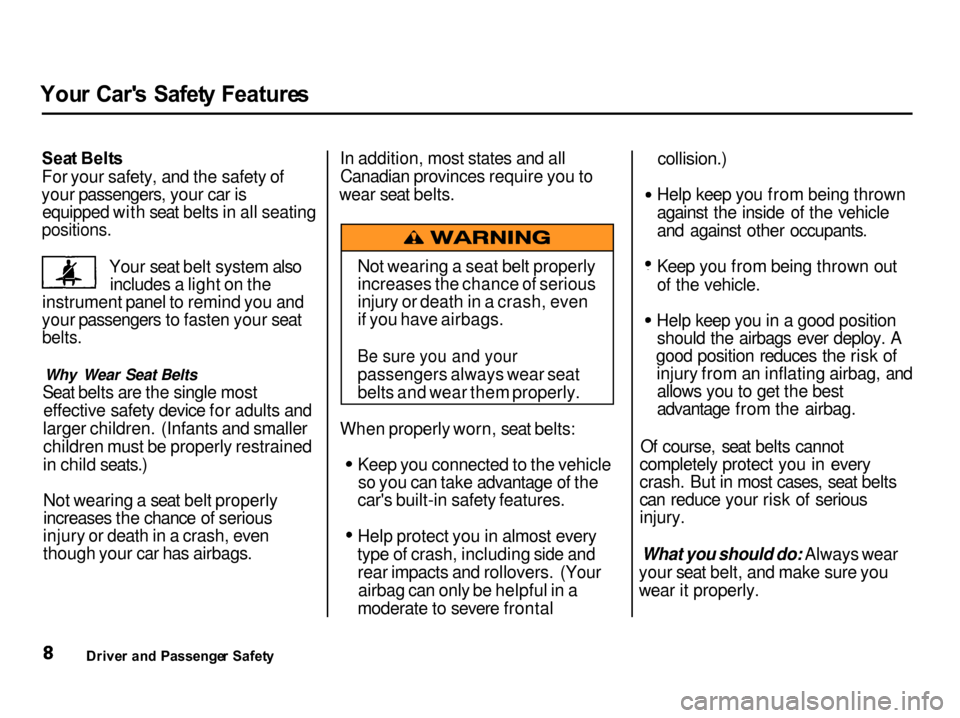
You
r Car' s Safet y Feature s
Sea t Belt s
For your safety, and the safety of
your passengers, your car is equipped with seat belts in all seating
positions.
Your seat belt system alsoincludes a light on the
instrument panel to remind you and
your passengers to fasten your seat
belts.
Why Wear Seat Belts
Seat belts are the single most effective safety device for adults and
larger children. (Infants and smaller children must be properly restrained
in child seats.)
Not wearing a seat belt properly
increases the chance of serious
injury or death in a crash, even
though your car has airbags. In addition, most states and all
Canadian provinces require you to
wear seat belts.
When properly worn, seat belts: Keep you connected to the vehicle
so you can take advantage of the
car's built-in safety features. Help protect you in almost every
type of crash, including side and rear impacts and rollovers. (Yourairbag can only be helpful in a
moderate to severe frontal
collision.)
Help keep you from being thrown
against the inside of the vehicle
and against other occupants.
Keep you from being thrown out
of the vehicle.
Help keep you in a good position
should the airbags ever deploy. A
good position reduces the risk of injury from an inflating airbag, andallows you to get the best
advantage from the airbag.
Of course, seat belts cannot
completely protect you in every
crash. But in most cases, seat belts
can reduce your risk of serious
injury.
What you should do: Always wear
your seat belt, and make sure you
wear it properly.
Drive r an d Passenge r Safet y Not wearing a seat belt properly
increases the chance of serious
injury or death in a crash, even
if you have airbags.
Be sure you and your
passengers always wear seat
belts and wear them properly.
Page 12 of 285
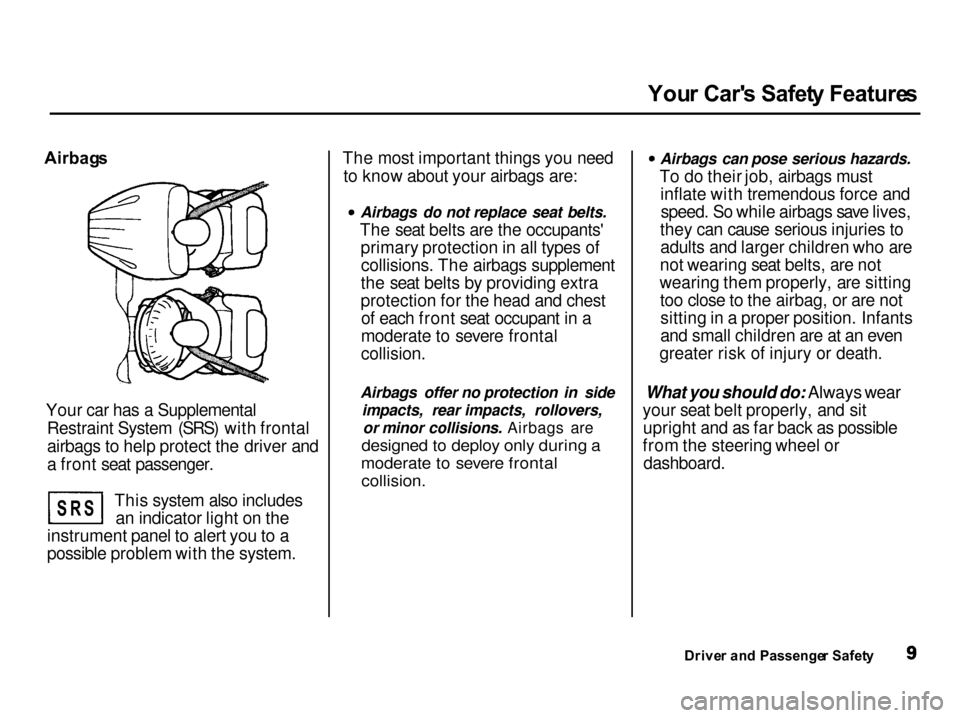
You
r Car' s Safet y Feature s
Airbag s
Your car has a Supplemental Restraint System (SRS) with frontal
airbags to help protect the driver and
a front seat passenger.
This system also includesan indicator light on the
instrument panel to alert you to a
possible problem with the system. The most important things you need
to know about your airbags are: Airbags do not replace seat belts.
The seat belts are the occupants' primary protection in all types ofcollisions. The airbags supplement
the seat belts by providing extra
protection for the head and chest of each front seat occupant in a
moderate to severe frontal
collision.
Airbags offer no protection in side
impacts, rear impacts, rollovers,or minor collisions. Airbags are
designed to deploy only during a
moderate to severe frontal
collision.
Airbags can pose serious hazards.
To do their job, airbags must inflate with tremendous force andspeed. So while airbags save lives,
they can cause serious injuries to adults and larger children who are
not wearing seat belts, are not
wearing them properly, are sitting too close to the airbag, or are notsitting in a proper position. Infants
and small children are at an even
greater risk of injury or death.
What you should do: Always wear
your seat belt properly, and sit upright and as far back as possible
from the steering wheel or
dashboard.
Driver an d Passenge r Safet y
S
R
S
Page 13 of 285
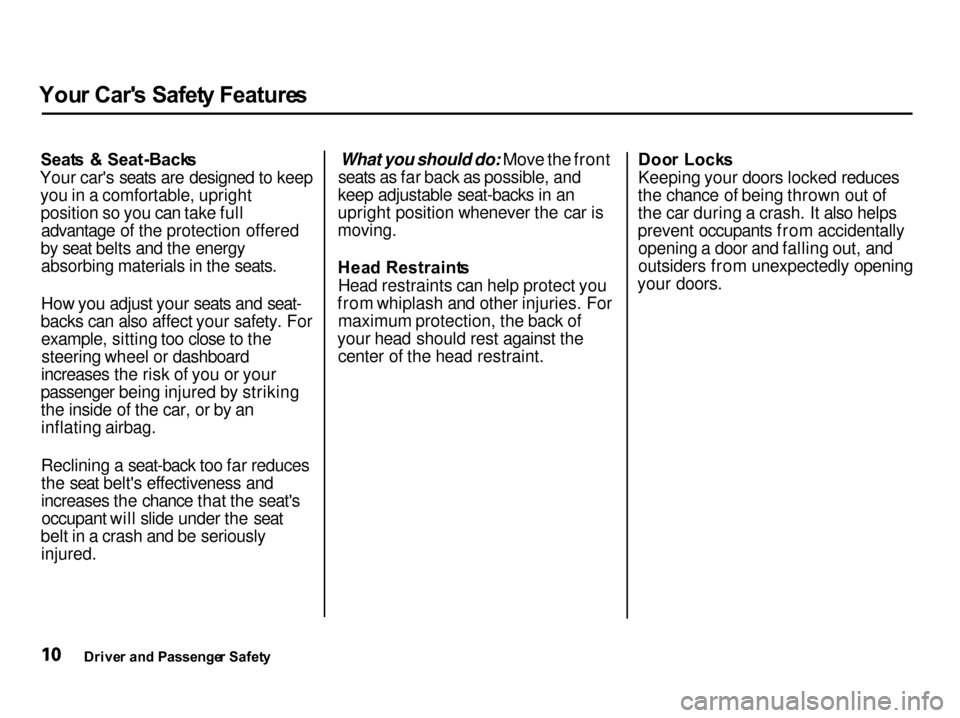
You
r Car' s Safet y Feature s
Seat s & Seat-Back s
Your car's seats are designed to keep you in a comfortable, uprightposition so you can take fulladvantage of the protection offered
by seat belts and the energy absorbing materials in the seats.
How you adjust your seats and seat-
backs can also affect your safety. For example, sitting too close to thesteering wheel or dashboard
increases the risk of you or your
passenger being injured by striking
the inside of the car, or by an inflating airbag.
Reclining a seat-back too far reduces
the seat belt's effectiveness and
increases the chance that the seat'soccupant will slide under the seat
belt in a crash and be seriously
injured.
What you should do: Move the front
seats as far back as possible, and
keep adjustable seat-backs in an
upright position whenever the car is
moving.
Hea d Restraint s
Head restraints can help protect you
from whiplash and other injuries. For maximum protection, the back of
your head should rest against the center of the head restraint. Doo
r Lock s
Keeping your doors locked reduces
the chance of being thrown out of
the car during a crash. It also helps
prevent occupants from accidentally opening a door and falling out, and
outsiders from unexpectedly opening
your doors.
Drive r an d Passenge r Safet y
Page 14 of 285
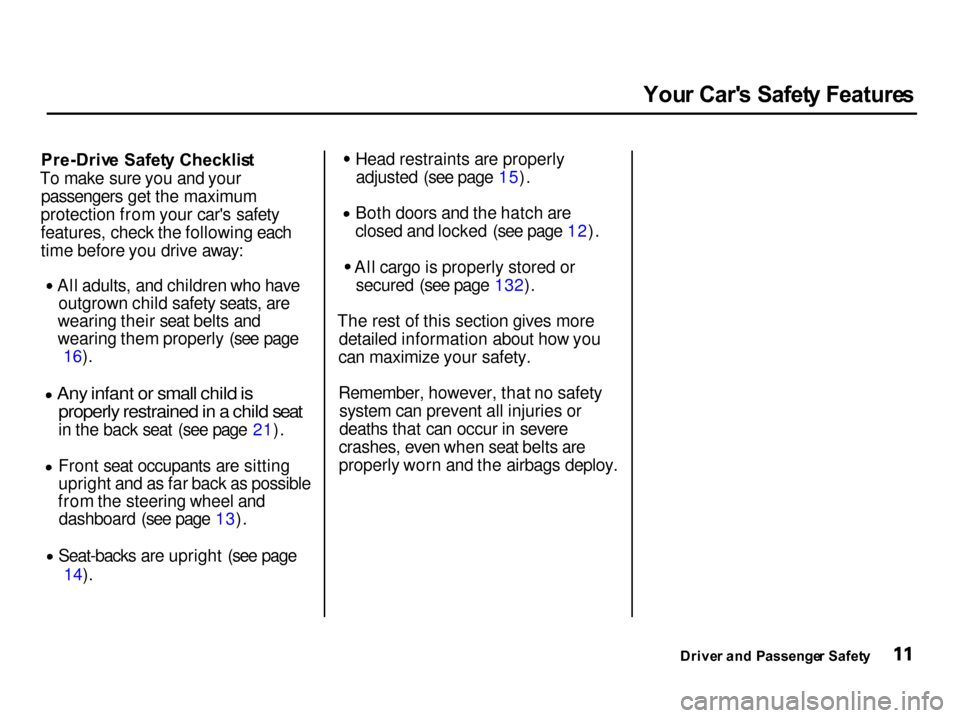
You
r Car' s Safet y Feature s
Pre-Driv e Safet y Checklis t
To make sure you and your passengers get the maximum
protection from your car's safety
features, check the following each
time before you drive away: All adults, and children who have
outgrown child safety seats, are
wearing their seat belts and
wearing them properly (see page 16).
Any infant or small child is
properly restrained in a child seat
in the back seat (see page 21). Front seat occupants are sitting
upright and as far back as possible
from the steering wheel and dashboard (see page 13). Seat-backs are upright (see page
14). Head restraints are properly
adjusted (see page 15). Both doors and the hatch are
closed and locked (see page 12).
All cargo is properly stored or
secured (see page 132).
The rest of this section gives more detailed information about how you
can maximize your safety.
Remember, however, that no safety system can prevent all injuries or
deaths that can occur in severe
crashes, even when seat belts are
properly worn and the airbags deploy.
Driver an d Passenge r Safet y
Page 15 of 285
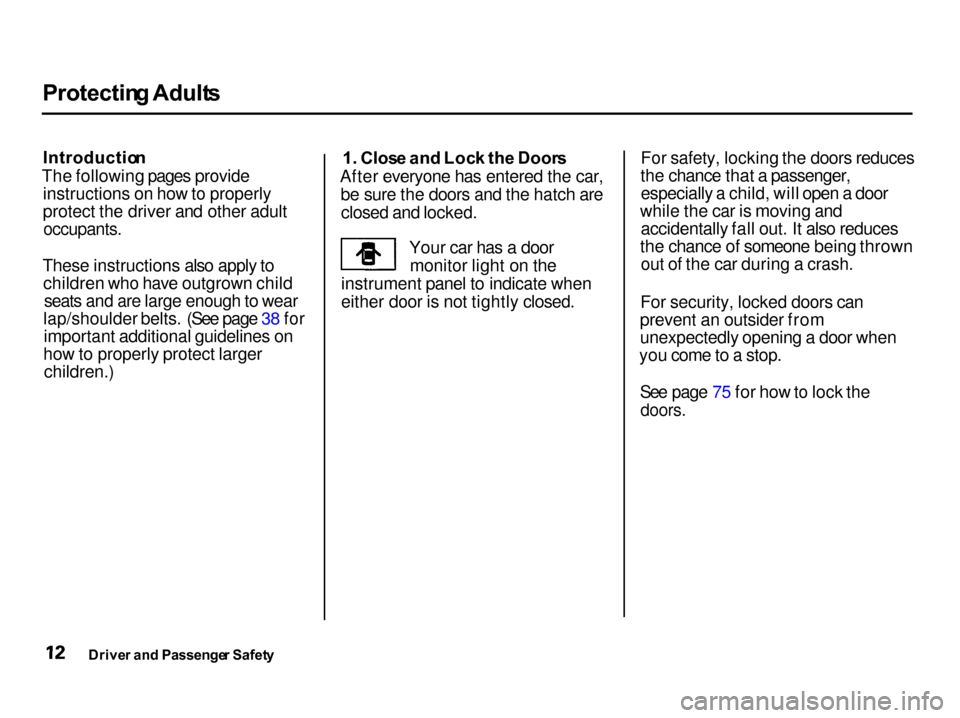
Protectin
g Adult s
Introductio n
The following pages provide instructions on how to properly
protect the driver and other adult
occupants.
These instructions also apply to children who have outgrown childseats and are large enough to wear
lap/shoulder belts. (See page 38 for important additional guidelines on
how to properly protect larger children.) 1
. Clos e an d Loc k th e Door s
After everyone has entered the car, be sure the doors and the hatch areclosed and locked.
Your car has a doormonitor light on the
instrument panel to indicate when
either door is not tightly closed. For safety, locking the doors reduces
the chance that a passenger, especially a child, will open a door
while the car is moving and accidentally fall out. It also reduces
the chance of someone being thrown out of the car during a crash.
For security, locked doors can
prevent an outsider from
unexpectedly opening a door when
you come to a stop.
See page 75 for how to lock the
doors.
Drive r an d Passenge r Safet y
Page 16 of 285
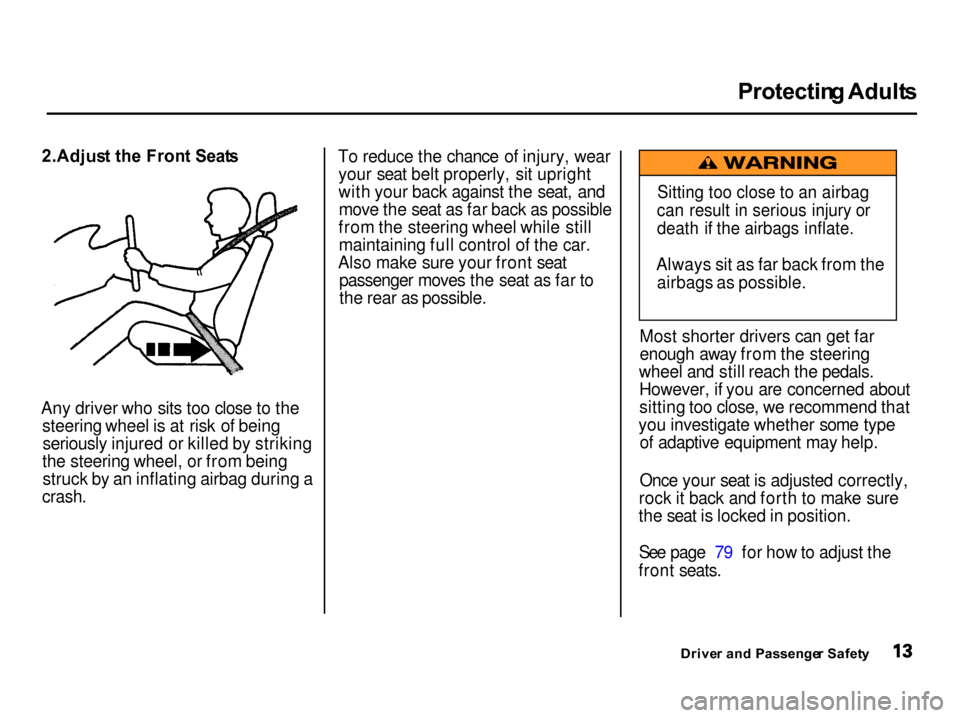
Protectin
g Adult s
2.Adjus t th e Fron t Seat s
Any driver who sits too close to the steering wheel is at risk of beingseriously injured or killed by striking
the steering wheel, or from being struck by an inflating airbag during a
crash.
To reduce the chance of injury, wear
your seat belt properly, sit upright
with your back against the seat, andmove the seat as far back as possible
from the steering wheel while still maintaining full control of the car.
Also make sure your front seat passenger moves the seat as far to
the rear as possible.
Most shorter drivers can get far
enough away from the steering
wheel and still reach the pedals. However, if you are concerned about
sitting too close, we recommend that
you investigate whether some type of adaptive equipment may help.
Once your seat is adjusted correctly,
rock it back and forth to make sure
the seat is locked in position.
See page 79 for how to adjust the
front seats.
Driver an d Passenge r Safet y
Sitting too close to an airbag
can result in serious injury or
death if the airbags inflate.
Always sit as far back from the airbags as possible.
Page 17 of 285
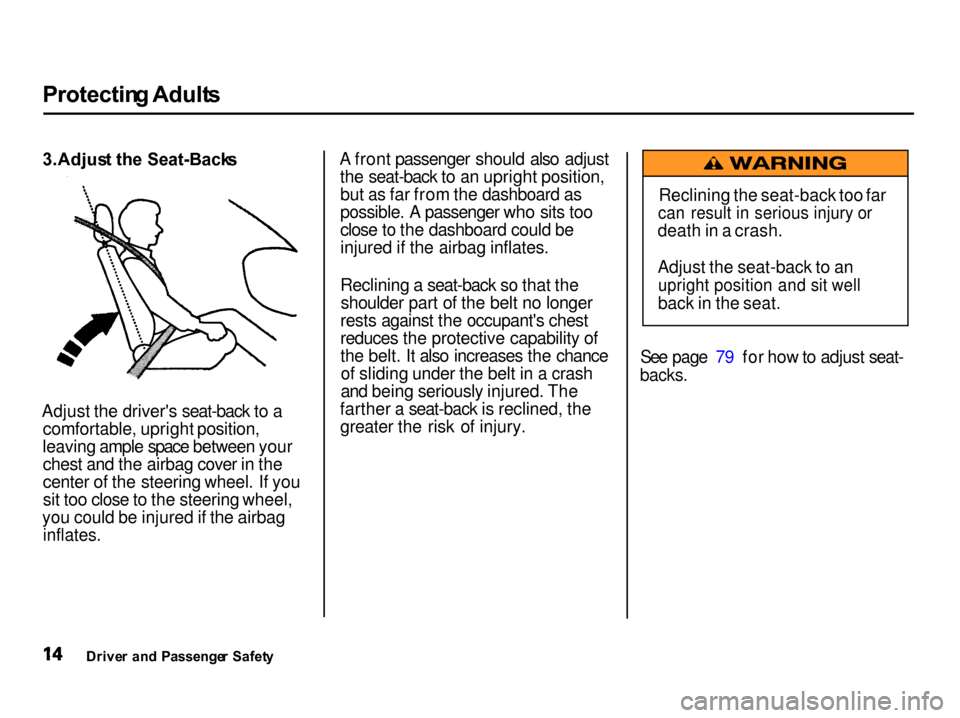
Protectin
g Adult s
3.Adjus t th e Seat-Back s
Adjust the driver's seat-back to a comfortable, upright position,
leaving ample space between your chest and the airbag cover in the
center of the steering wheel. If you
sit too close to the steering wheel,
you could be injured if the airbag
inflates.
A front passenger should also adjust
the seat-back to an upright position,but as far from the dashboard as
possible. A passenger who sits too
close to the dashboard could be
injured if the airbag inflates.
Reclining a seat-back so that theshoulder part of the belt no longer
rests against the occupant's chest
reduces the protective capability of
the belt. It also increases the chance of sliding under the belt in a crash
and being seriously injured. The
farther a seat-back is reclined, the greater the risk of injury. See page 79 for how to adjust seat-
backs.
Drive r an d Passenge r Safet y Reclining the seat-back too far
can result in serious injury or
death in a crash.
Adjust the seat-back to an
upright position and sit well
back in the seat.
Page 18 of 285

Protectin
g Adult s
4 Adjus t th e Hea d Restraint s
Before driving, make sure everyone
with an adjustable head restraint has properly positioned the head
restraint. The restraint should be
positioned so the back of theoccupant's head rests against the
center of the restraint. A taller
person should adjust the restraint as
high as possible. Properly adjusted head restraints
will help protect occupants from
whiplash and other crash injuries.
See page 82 for how to adjust the
head restraints.
Driver an d Passenge r Safet y
Improperly positioning head
restraints reduces their
effectiveness and you can be
seriously injured in a crash.
Make sure head restraints are
in place and positioned properly
before driving.
Page 19 of 285

Protectin
g Adult s
5.Faste n an d Positio n th e Sea t
Belt s
Insert the latch plate into the buckle,
then tug on the belt to make sure the
belt is securely latched. Also check
that the belt is not twisted, because a
twisted belt can cause serious
injuries in a crash.
Position the lap part of the belt as
low as possible across your hips,
then pull up on the shoulder part of
the belt so the lap part fits snugly.
This lets your strong pelvic bones take the force of a crash and reduces
the chance of internal injuries. If necessary, pull up on the belt again
to remove any slack from the shoulder part, then check that the
belt rests across the center of your chest and over your shoulder. Thisspreads the forces of a crash over
the strongest bones in your upper
body.
Drive r an d Passenge r Safet y
Improperly positioning the seat
belts can cause serious injury
or death in a crash.
Make sure all seat belts are
properly positioned before
driving.
Page 20 of 285
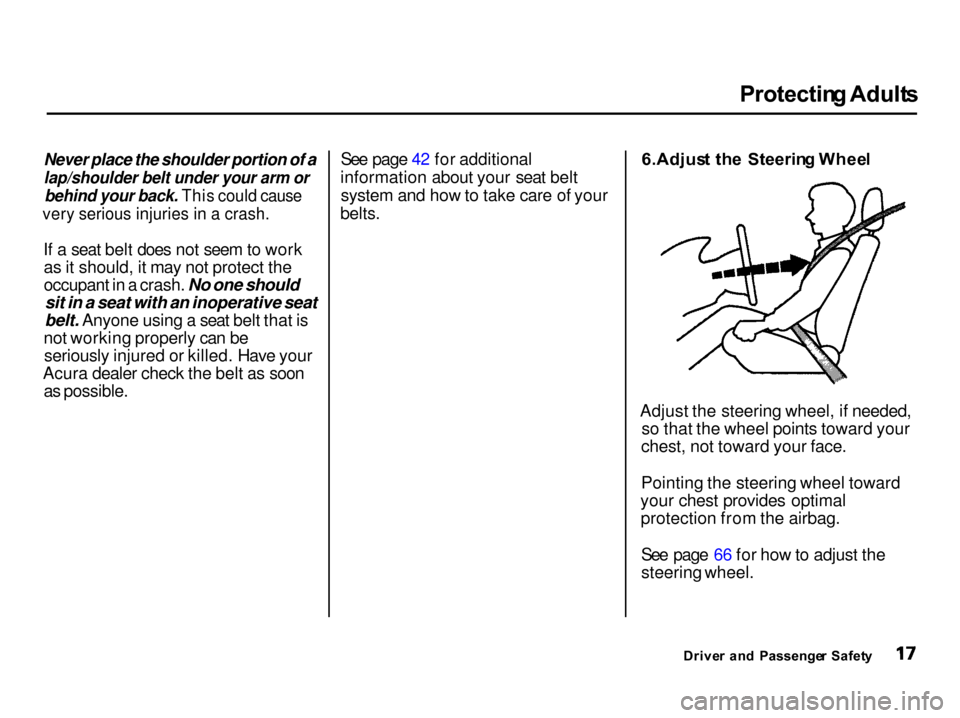
Protectin
g Adult s
Never place the shoulder portion of a
lap/shoulder belt under your arm or behind your back. This could cause
very serious injuries in a crash.
If a seat belt does not seem to workas it should, it may not protect the
occupant in a crash. No one should
sit in a seat with an inoperative seat
belt. Anyone using a seat belt that is
not working properly can be seriously injured or killed. Have your
Acura dealer check the belt as soon as possible. See page 42 for additional
information about your seat belt system and how to take care of your
belts.
6.Adjus
t th e Steerin g Whee l
Adjust the steering wheel, if needed, so that the wheel points toward your
chest, not toward your face.
Pointing the steering wheel toward
your chest provides optimal protection from the airbag.
See page 66 for how to adjust the
steering wheel.
Driver an d Passenge r Safet y